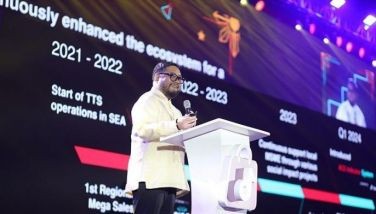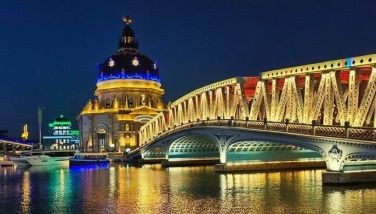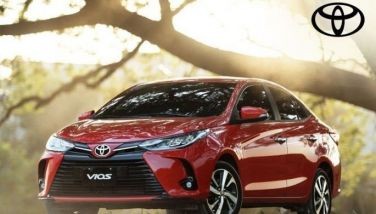The business of cars hows
August 7, 2002 | 12:00am
Think cars and you instantly associate wit with men, with their need for speed and velocity, with their passion for roaring sports cars and mean dream machines, with their arduous love for mortorsports.
It’s a man’s world alright, but as far as Marisa D. Nallana is concerned, cars and automotive are her realm too, at least since 13 years ago. Nallana is the prime mover of "Motorshow International," the country’s biggest and longest-running auto and cycle show that is scheduled on October 2-6 at the World Trade Center, Pasay City, organized by Philippine Exhibits and Themeparks Corp. (PETCO).
For Nallana, organizing the Motorshow has already become as familiar as steering her own car through metro traffic. Twelve years ago, the car and cycle show was a fledgling and struggling venue that begged for recognition and acceptance. "It was like the British music scene before the Beatles, or the Chicago stadium before Michael Jordan and it isn’t hard to see why," Nallana apologizes.
Around that time, the Philippine automotive industry had just come out of the mire. The political and economic crisis had driven major car manufacturers out of the country. With the national economy taking a dive faster than a Corvette could accelerate from 0 to 60, no sane company wanted to do business here.
The car industry became moribund, if not dead. In the latter part of the 80s, a few carmakers started staging a comeback in the local market, all of them Japanese, notably Nissan, Toyota and Mitsubishi. And yet, the industry could hardly be described as having recovered.
The concept of a Motorshow International can be traced to what was then known as the Transportation Show (Transhow) started in 1981 in the then Philcite as a trade fair for the air, land and sea transport industries. Nallana had to steer her group through several obstacles–from a dearth in attendance and sponsors to a lackluster exhibit. "The concept of a car show was all new to the Filipino. There were trade shows and fair, like tiangges, etc. but a car show? If people wanted to see new models, they go to the showrooms of different car companies but never to one venue. Motorshows are big in Japan or Germany but here, they didn’t think a car show in the real sense of the world could be possible," Nallana observes.
But Nallana and her team were not fazed. On its third year, in an attempt to draw more public interest and attendance. Transhow introduced special events to give the exhibit a more relaxed atmosphere. Thus were born features such as the auto exchange, the classic and vintage cars exhibits, slaloms, car clubs, etc. The added attractions proved to be a big crown drawer and the once staid and formal auto trade fair exhibit had taken on a distinctive Pinoy face that ordinary Filipinos were able to relate to.
In 1989, PETCO, a new company established by Nallana and other partners, gambled to stage a full car show. "It was then dominated by car parts and accessories dealers because of the depressed market for brand new cars. Customers just wanted to upgrade their cars and not buy new ones. Modified and second hand car dealers were also active participants."
Suffice it to say, this car show was a big risk, considering that it was very much dependent on the pervading economic standing of the country. But Nallana knew there was a time and day her baby. "That came in 1992 when a new President was sworn in and major car assemblers, how have long been watching from the sidelines, took the promise of a new economic prosperity as a signal and literally came in droves to Motorshow," Nallana recalls. Since then, Motorshow has laid claim to truly being the country’s premiere auto show, a car buff’s Disneyland, so to speak and much-awaited event for car and accessories companies, service providers and many more. It is where new models are launched and where car clubs like the Volkswagen Car Club, Vintage Car Clubs of the Philippines, Classic Car Club of the Philippines, Mercedes Benz Club, Mini Car Club, Mustang Clubs, etc. converge to showcase their babies.
In 1997, when they began using the World Trade Center as the venue, it was clearer indication that the local automotive industry had come of age to take on competition from giant multinational corporations which display wholly imported luxury cars, vans and sport utility vehicle during the show.
Unlike other trade show, a Motorshow takes about a year to set up. Abroad, it’s two years minimum.
This year, despite the downturn in worldwide economy, Nallana is hopeful that the multi-million peso motoring industry will have a show of force.
"Cars/transport are a necessity, no longer a luxury. It is a part of our daily life. What we are trying to say at Motorshow is that despite the not so good business climate, we have no other recourse but to continue and move on. We cannot stop selling nor stop doing business until things get better. It might be too late."
In fact for this year’s show, major car companies like Jaguar Philippines will be joining to showcase their latest models.
"In a way, trade shows and exhibits in the Philippines context are relatively new. The country’s biggest industries in fact do not have established trade shows of their own and only lately have there been visible signs that industries had realized the value of clustering, of putting together their products and services to showcase. Against this backdrop, the automotive industry is way ahead because we have been staging the Motorshow for 13 years now," explains Nallana.
It’s a man’s world alright, but as far as Marisa D. Nallana is concerned, cars and automotive are her realm too, at least since 13 years ago. Nallana is the prime mover of "Motorshow International," the country’s biggest and longest-running auto and cycle show that is scheduled on October 2-6 at the World Trade Center, Pasay City, organized by Philippine Exhibits and Themeparks Corp. (PETCO).
For Nallana, organizing the Motorshow has already become as familiar as steering her own car through metro traffic. Twelve years ago, the car and cycle show was a fledgling and struggling venue that begged for recognition and acceptance. "It was like the British music scene before the Beatles, or the Chicago stadium before Michael Jordan and it isn’t hard to see why," Nallana apologizes.
Around that time, the Philippine automotive industry had just come out of the mire. The political and economic crisis had driven major car manufacturers out of the country. With the national economy taking a dive faster than a Corvette could accelerate from 0 to 60, no sane company wanted to do business here.
The car industry became moribund, if not dead. In the latter part of the 80s, a few carmakers started staging a comeback in the local market, all of them Japanese, notably Nissan, Toyota and Mitsubishi. And yet, the industry could hardly be described as having recovered.
The concept of a Motorshow International can be traced to what was then known as the Transportation Show (Transhow) started in 1981 in the then Philcite as a trade fair for the air, land and sea transport industries. Nallana had to steer her group through several obstacles–from a dearth in attendance and sponsors to a lackluster exhibit. "The concept of a car show was all new to the Filipino. There were trade shows and fair, like tiangges, etc. but a car show? If people wanted to see new models, they go to the showrooms of different car companies but never to one venue. Motorshows are big in Japan or Germany but here, they didn’t think a car show in the real sense of the world could be possible," Nallana observes.
But Nallana and her team were not fazed. On its third year, in an attempt to draw more public interest and attendance. Transhow introduced special events to give the exhibit a more relaxed atmosphere. Thus were born features such as the auto exchange, the classic and vintage cars exhibits, slaloms, car clubs, etc. The added attractions proved to be a big crown drawer and the once staid and formal auto trade fair exhibit had taken on a distinctive Pinoy face that ordinary Filipinos were able to relate to.
In 1989, PETCO, a new company established by Nallana and other partners, gambled to stage a full car show. "It was then dominated by car parts and accessories dealers because of the depressed market for brand new cars. Customers just wanted to upgrade their cars and not buy new ones. Modified and second hand car dealers were also active participants."
Suffice it to say, this car show was a big risk, considering that it was very much dependent on the pervading economic standing of the country. But Nallana knew there was a time and day her baby. "That came in 1992 when a new President was sworn in and major car assemblers, how have long been watching from the sidelines, took the promise of a new economic prosperity as a signal and literally came in droves to Motorshow," Nallana recalls. Since then, Motorshow has laid claim to truly being the country’s premiere auto show, a car buff’s Disneyland, so to speak and much-awaited event for car and accessories companies, service providers and many more. It is where new models are launched and where car clubs like the Volkswagen Car Club, Vintage Car Clubs of the Philippines, Classic Car Club of the Philippines, Mercedes Benz Club, Mini Car Club, Mustang Clubs, etc. converge to showcase their babies.
In 1997, when they began using the World Trade Center as the venue, it was clearer indication that the local automotive industry had come of age to take on competition from giant multinational corporations which display wholly imported luxury cars, vans and sport utility vehicle during the show.
This year, despite the downturn in worldwide economy, Nallana is hopeful that the multi-million peso motoring industry will have a show of force.
"Cars/transport are a necessity, no longer a luxury. It is a part of our daily life. What we are trying to say at Motorshow is that despite the not so good business climate, we have no other recourse but to continue and move on. We cannot stop selling nor stop doing business until things get better. It might be too late."
In fact for this year’s show, major car companies like Jaguar Philippines will be joining to showcase their latest models.
"In a way, trade shows and exhibits in the Philippines context are relatively new. The country’s biggest industries in fact do not have established trade shows of their own and only lately have there been visible signs that industries had realized the value of clustering, of putting together their products and services to showcase. Against this backdrop, the automotive industry is way ahead because we have been staging the Motorshow for 13 years now," explains Nallana.
BrandSpace Articles
<
>
- Latest
Latest
Latest
March 15, 2024 - 3:12pm
March 15, 2024 - 3:12pm
February 15, 2024 - 1:10pm
February 15, 2024 - 1:10pm
January 29, 2024 - 5:25pm
January 29, 2024 - 5:25pm
January 24, 2024 - 2:30pm
January 24, 2024 - 2:30pm
Recommended




























